Affordable Porsches: 2005–2012 Boxsters/Caymans ride swell of younger interest
Great news, Porsche nuts—the Hagerty Price Guide now tracks the 987 generation of the Boxster (2005–2012) and Cayman (2006–2012). Armed with this set of data, we can now easily compare the second generation of Porsche’s water-cooled, mid-engine marvel against established models in our price guide to see how their valuation trends stack up.
If GT3s, 993s, Turbos, and early longhoods are the buttercream frosting on the Porsche market, it’s the fleet of 996/997-generation Carreras (1997–2013) and 986/987-gen mid-engine variants (1996–2012) that make up the fluffy yellow cake. The 986 Boxster and 996 911 put Porsche back on the sales charts after the marque’s financially dismal 1990s and set the stage for modern Porsche sports cars. It was the 997-gen 911 (2004–2013) and the 987-gen twins, though, that made the new formula more Porsche-like.
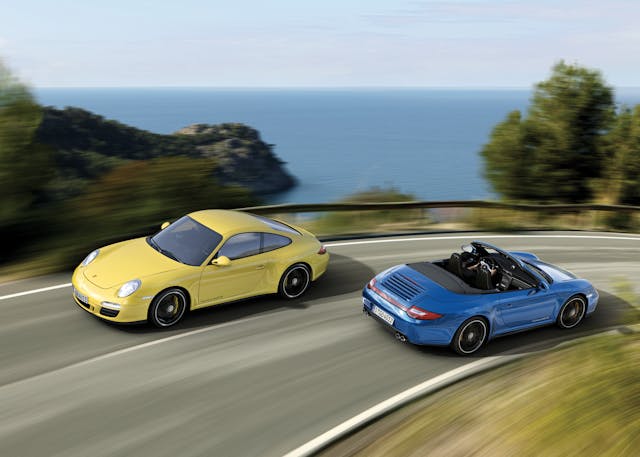
Although unquestionable sales successes, the 986-gen Boxster and 996-gen 911 ruffled more than a few feathers with the Porsche faithful in the late ’90s. Fans were put off by the 996’s plastic-fantastic interior, mechanical shortcomings, and its alarming performance and aesthetic overlap with baby brother 986. Porsche heard this outcry and brought about changes in 2005.
The reactionary 997 and accompanying 987 convinced Porschephiles to put away their pitchforks. The infamous IMS failure still occasionally struck a 997, but incidence rates were magnitudes lower than early iterations of the 996. Porsche tightened build quality, shaped up the exterior lines—this time creating clear model differentiation—and further established the model hierarchy that remains mostly unchanged to this day. And, for those who dreamed of a Boxster coupe, the popular Cayman made its debut.
The 997 is as beloved and sought-after as the 996 is controversial. As a result, values for the 997 never really dipped to the 996’s bargain-basement levels. As of this writing, a 2004 Carrera (996-gen) in Condition #3 (Good, or driver condition) trades for an average of $28,000. One model year later, a 2005 Carrera (997) in the same condition claims an average of $46,000.
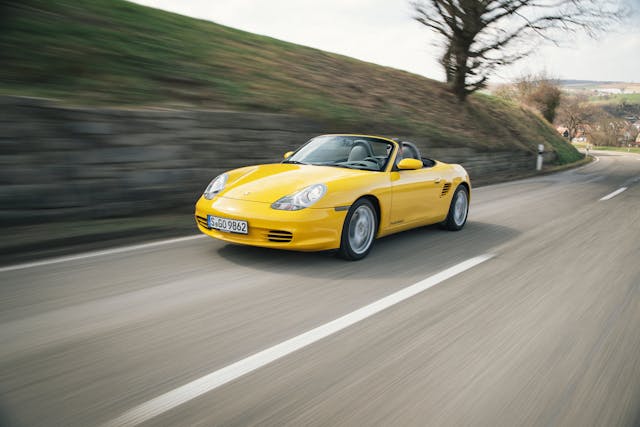
That’s almost $20,000 extra for an only incremental improvement in real-world performance. It’s the same with the 987; there’s a whopping $10,000 delta between a 2004 Boxster ($14,000) and 2005 Boxster ($24,000) in #3 condition. The mechanical differences between a 986 and 987 are more meaningful than between the 996 and 997, but that’s still a significant premium.
Regardless of the delta between generations, values are on the rise across the board. The 986—ever the cheap and cheerful budget Porsche—is up 34 percent since September 2019, with an average of $23,000 for all first-gen Boxster variants and model years in Condition #2. As 987 Cayman/Boxsters shared the 997’s aversion to bottomless depreciation, values remained somewhat stable since September of 2019, gradually raising 25 percent to an umbrella average of $43,000 for all variants in Condition #2.
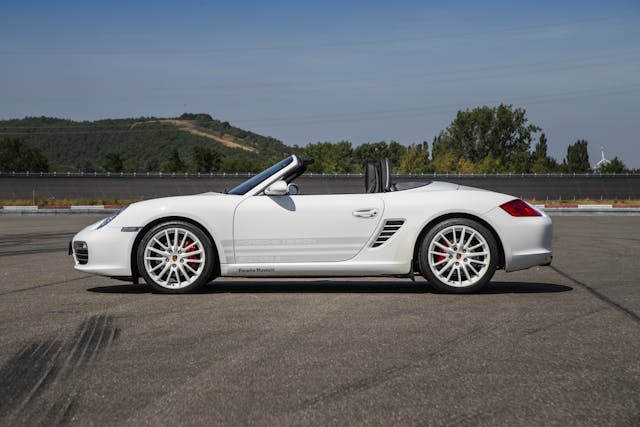
Demand for any and all 911s continues unabated, and as one of the breed’s high-water marks, the 997 saw a 55 percent boost in value since September 2019 to a stunning $115,300. That’s an alarming figure until you factor in the influence of rare and low-production variants like the GT3, RS 4.0, Turbo, Sport Classic, and GT2 RS. Most 997s trade somewhere in the $50,000-to-$75,000 range.
Recent auction volume for the 997 and 987 reflects their enduring desirability. Since 2019, online and live auction sales have more than doubled for both the 997 and 987. A total of 570 997s are expected to sell by close of 2022, with a strong 76 percent sell-through rate that’s up from 2019’s 69 percent. 85 987s are expected to sell by the end of this year, although the sell-through rate dropped to 72 percent from 2019’s 76 percent. This lower rate may be influenced the comparatively limited supply.

Let’s huck a curveball in the mix—a lightweight, barebones, semi-exotic slider. The advent of the 987 into our hallowed price guide means it now faces off against segment-mate Lotus Elise, a car we’ve tracked for a while. The comparison isn’t entirely apples-to-apples, with only 6300 Elises imported to the U.S. between 2005 and 2011 model years, but this is reflected in the Elise’s $60,100 average value for a car in #2 condition. Like the Porsches, values are up, with the Elise enjoying a 54 percent curve since September 2019.
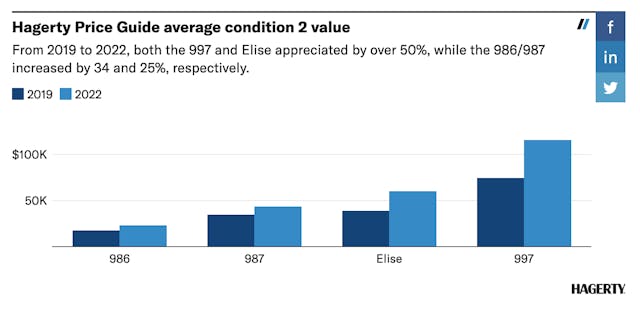
Per our data, the swell for each of the aforementioned cars is the result of increased interest from younger demographics. 46 percent of 987 insurance quotes through Hagerty are from Gen-X or younger, an increase in 11.1 percent since 2019; the 986 is close behind, with 43 percent of quotes from the same age range, up 7.1 percent since 2019.
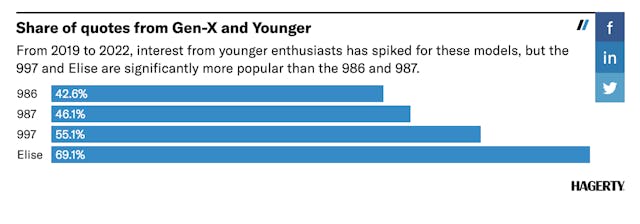
The 997 appears to be a fan favorite with younger Porsche enthusiasts, beating both 986 and 987 with 55 percent of quotes from Gen-X or younger, up 7.8 percent since 2019. Impressive, and telling; the 911 proves it has staying power even over the more affordable, mid-engine 987. The Elise kicks ’em all to the curb, though, with 69 percent of quotes from the same youthful range, up 7.8 percent since 2019. This high level of younger engagement bodes well for future appreciation for all of these models.
Check out the Hagerty Media homepage so you don’t miss a single story, or better yet, bookmark it.
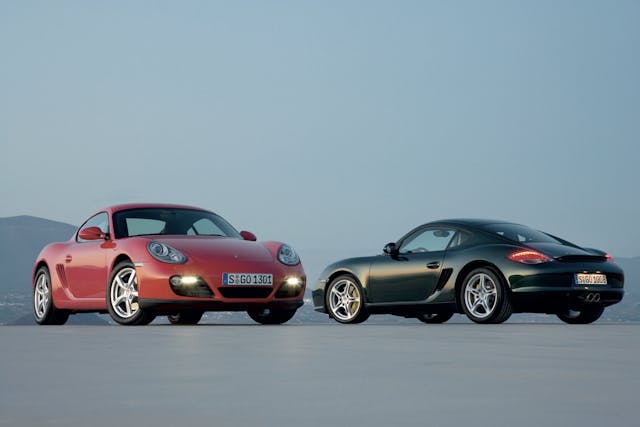


The 987 and 997 are really something special if you read any contemporary reviews of them. The 997 was always the best in class as I recall and was often called “perfect”. And the 987 fixed all the things which didn’t really work well in the 986 and made it one really sweet little car. It’s kind of sad looking at the current 992 (911) and thinking back on the 996 — the 997 represents the best of everything the 911 series could be in the modern liquid cooled era and now it’s over. The current car is too big, too isolating, too digital dashboard nonsense, etc.
Happy to see the 987 added to the guide. Thanks!
The post 2004 IMS bearing is not magnitudes better. Somewhat is a better term. It is still a highly loaded sealed ball bearing inside a hot engine. Horrible design. Should have been a plain oil fed bearing. Another issue is it is not replaceable like the earlier bearing without a complete tear down. If you are thinking about buying one you must have the oil filter cut apart to look for metal and plastic. Also camshaft deviation must be checked. Engines are 30K plus.
I have an 03 986 Boxster base w/Tiptronic. 124k. Uses no oil although an occasional puff of smoke on initial startup. Valve guide seals? AZ car. IMS bearing replaced w/LN dual row. The car runs great, but, will throw an engine check light when running it full throttle through the gears. Could this be related to the camshaft deviation issue? If so, would there be any issue just driving it this way?
Hi Jerry, 01 986S owner here. It’s best to check the code and go from there, but I think you’d have bigger problems if the deviation was off. My guess? Cats or O2 sensor.
I love articles like this because they will hopefully scare people away from the 996. I’d like the 996 cars to get cheaper so I can buy more!
Anyone else like their eggs fried?
Uggghhh, another duplicated article.
Thanks!
Well done.
Will you do an update a year from now? After recession concerns are (hopefully) resolved and interest rates have (also hopefully) plateaued or dropped?